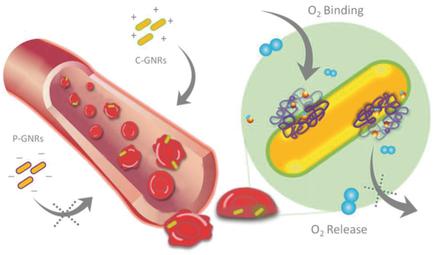Our official English website, www.x-mol.net, welcomes your feedback! (Note: you will need to create a separate account there.)
Hematological Effects of Gold Nanorods on Erythrocytes: Hemolysis and Hemoglobin Conformational and Functional Changes
Advanced Science ( IF 15.1 ) Pub Date : 2017-09-25 , DOI: 10.1002/advs.201700296 Xingchen Zhao 1, 2 , Dawei Lu 1, 2 , Qian S. Liu 1, 2 , Yiling Li 1, 2 , Rui Feng 1, 2 , Fang Hao 1, 2 , Guangbo Qu 1, 2 , Qunfang Zhou 1, 2 , Guibin Jiang 1, 2
Advanced Science ( IF 15.1 ) Pub Date : 2017-09-25 , DOI: 10.1002/advs.201700296 Xingchen Zhao 1, 2 , Dawei Lu 1, 2 , Qian S. Liu 1, 2 , Yiling Li 1, 2 , Rui Feng 1, 2 , Fang Hao 1, 2 , Guangbo Qu 1, 2 , Qunfang Zhou 1, 2 , Guibin Jiang 1, 2
Affiliation

|
Gold nanorods (GNRs) are a unique class of metal nanostructures that have attractive potentials in biomedical applications, and the concern on their biological safety is concomitantly increasing. Hemocompatibility is extremely important as their contact with blood circulation is unavoidable during in vivo delivery. Herein, two kinds of GNRs coated with hexadecyltrimethylammonium bromide (C‐GNRs) or poly(sodium‐p‐styrenesulfonate) are used to test their potential toxicological effects in blood. C‐GNRs with positive surface charges efficiently induce hemolysis when encountering erythrocytes. Cellular internalization of C‐GNRs is found, and they subsequently bind with hemoglobin, forming bioconjugates. The interaction between hemoglobin and C‐GNR (stoichiometry 32.7:1) is regulated by electrostatic forces. Chromophores like tryptophan (Trp) are found to interact with C‐GNRs, causing enhancement in fluorescence intensity. The conformation of protein is partially altered, evidenced by decrease in α‐helical, increase in β‐sheet and random coil of hemoglobin. Although C‐GNRs do not essentially decrease oxygen binding capacity of hemoglobin, they hamper oxygen release from the protein. Heme, the oxygen binding unit, releases from hemoglobin upon C‐GNR treatment, which could contribute to C‐GNR‐induced hemolysis. This study demonstrates the hematological effects of GNRs, revealing their potential risk in biomedical applications.
中文翻译:

金纳米棒对红细胞的血液学影响:溶血和血红蛋白的构象和功能变化
金纳米棒(GNR)是一类独特的金属纳米结构,在生物医学应用中具有诱人的潜力,因此对其生物安全性的关注也日益增加。血液相容性非常重要,因为在体内分娩期间不可避免地要与血液循环接触。这里,有两种涂有十六烷基三甲基溴化铵(C‐GNRs)或聚(钠p-苯乙烯磺酸盐)用于测试其在血液中的潜在毒理作用。具有正表面电荷的C‐GNR在遇到红细胞时可有效诱导溶血。发现了C-GNRs的细胞内在化,随后它们与血红蛋白结合,形成生物结合物。血红蛋白和C-GNR之间的相互作用(化学计量比32.7:1)受静电力调节。色氨酸(Trp)等发色团与C-GNR相互作用,导致荧光强度增强。蛋白质的构象部分改变,表现为α-螺旋减少,β-折叠增加和血红蛋白无规卷曲。尽管C-GNR并没有从本质上降低血红蛋白的氧结合能力,但它们阻碍了氧从蛋白质中释放。血红素是氧结合单位,经过C‐GNR处理后会从血红蛋白中释放出来,这可能导致C‐GNR引起的溶血。这项研究证明了GNRs的血液学效应,揭示了其在生物医学应用中的潜在风险。
更新日期:2017-09-25
中文翻译:

金纳米棒对红细胞的血液学影响:溶血和血红蛋白的构象和功能变化
金纳米棒(GNR)是一类独特的金属纳米结构,在生物医学应用中具有诱人的潜力,因此对其生物安全性的关注也日益增加。血液相容性非常重要,因为在体内分娩期间不可避免地要与血液循环接触。这里,有两种涂有十六烷基三甲基溴化铵(C‐GNRs)或聚(钠p-苯乙烯磺酸盐)用于测试其在血液中的潜在毒理作用。具有正表面电荷的C‐GNR在遇到红细胞时可有效诱导溶血。发现了C-GNRs的细胞内在化,随后它们与血红蛋白结合,形成生物结合物。血红蛋白和C-GNR之间的相互作用(化学计量比32.7:1)受静电力调节。色氨酸(Trp)等发色团与C-GNR相互作用,导致荧光强度增强。蛋白质的构象部分改变,表现为α-螺旋减少,β-折叠增加和血红蛋白无规卷曲。尽管C-GNR并没有从本质上降低血红蛋白的氧结合能力,但它们阻碍了氧从蛋白质中释放。血红素是氧结合单位,经过C‐GNR处理后会从血红蛋白中释放出来,这可能导致C‐GNR引起的溶血。这项研究证明了GNRs的血液学效应,揭示了其在生物医学应用中的潜在风险。



























 京公网安备 11010802027423号
京公网安备 11010802027423号